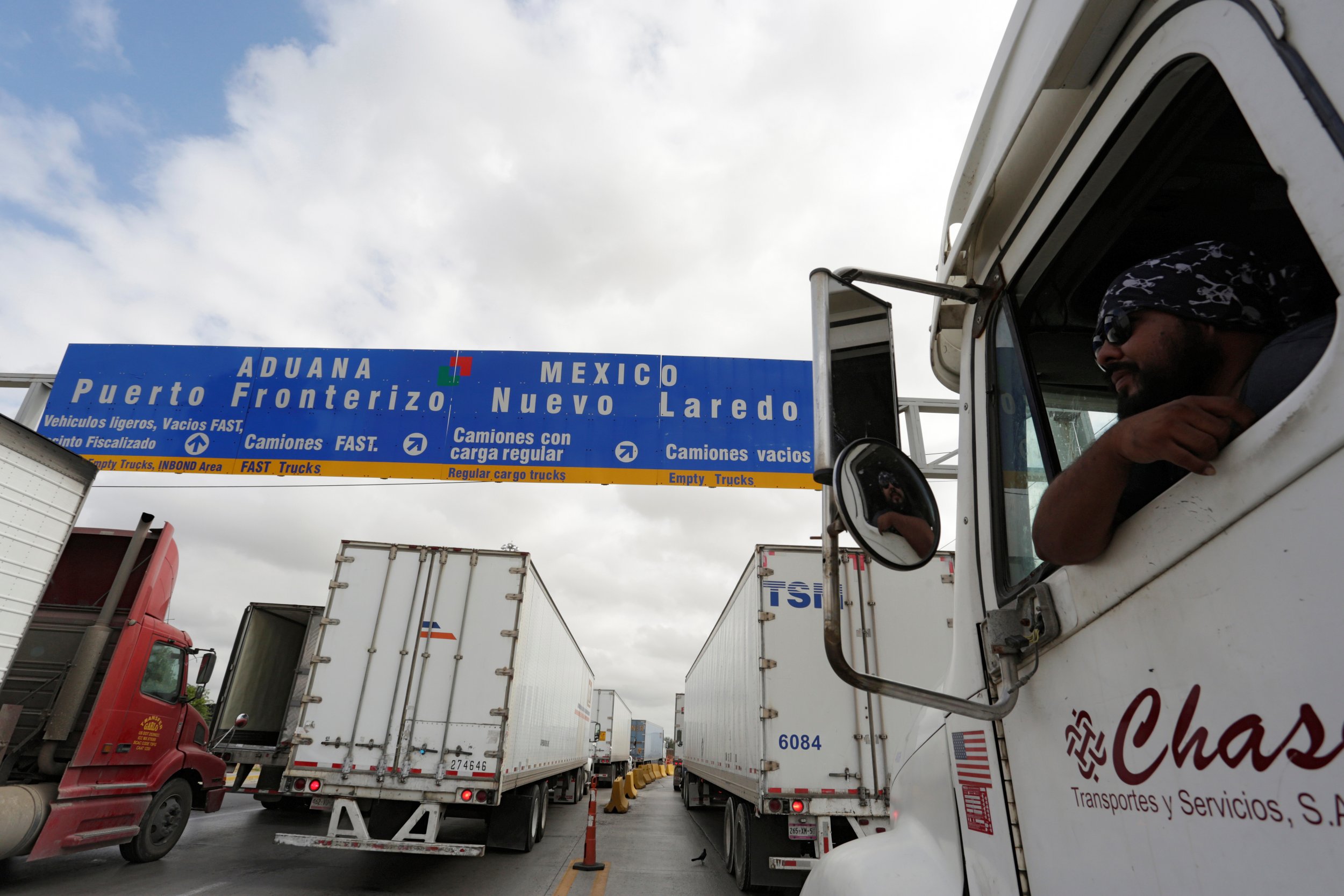
This article originally appeared on The Motley Fool.
Will Donald Trump follow through on his threat to shut down imports from Mexico?
It seems pretty clear that he'll try to deliver in some way on one of his most frequently repeated promises: to renegotiate or dismantle the North American Free Trade Agreement (NAFTA).
If he succeeds, that will be a costly headache for Ford Motor Company, General Motors, and just about all of the other big global automakers.
What Trump has promised to do about NAFTA
First, let's look at what Trump might try to do. In his seven-point trade plan, Trump said that if elected, he would:
Tell NAFTA partners that we intend to immediately renegotiate the terms of that agreement to get a better deal for our workers. If they don't agree to a renegotiation, we will submit notice that the U.S. intends to withdraw from the deal. Eliminate Mexico's one-side backdoor tariff through the VAT and end sweatshops in Mexico that undercut U.S. workers.
Trump also, famously, castigated automakers generally and Ford in particular for building new factories in Mexico and not in the United States. He even suggested that he'd try to enact a 35 percent tax on vehicles imported from Mexico.
One way or another, it seems clear that Trump will try to end free trade between the U.S. and its southern neighbor. That means (again, if he's successful) that vehicles coming into the U.S. from Mexico would face a tariff, probably a steep one. That would disrupt a lot of commerce, and impact a lot of automakers.
Since official reports of exports and imports are tallied in terms of financial value, it can be hard to tell exactly how many cars and trucks are imported into the U.S. from other countries.
But we know there are a lot of them: According to figures from the Mexican Automotive Industry Association, about 79 percent of the 2.9 million vehicles built in Mexico this year through October were exported. About 86 pcrcent of those exports, just under 2 million, went to North America, and the vast majority of those were sent to the U.S.
There are more coming: According to a recent report from the Center for Automotive Research (CAR), new factories that are under construction in Mexico will push the country's total production capacity over 5 million vehicles a year sometime in 2018.
Those factories are getting built because right now, it makes very good business sense for American automakers to build cars and trucks in Mexico and then import them into the U.S.
Why automakers have been building factories in Mexico
The list of auto factories in Mexico is a long one, and it has been growing quickly in recent years. Just since 2014, Mazda, Honda, Volkswagen and Audi, and Hyundai and Kia have all opened plants in Mexico. There are more on the way: Ford, Nissan, BMW, Volvo and Toyota all have Mexican factories under construction or in the works now. They'll join GM, Fiat Chrysler Automobiles and other vehicle manufacturers that have had factories in Mexico for several years.
But why Mexico? Lower-cost labor is part of the story, but there's quite a bit more to it:
- Free trade with other countries: Thanks to free-trade deals, exports from Mexico are exempt from tariffs in 44 other countries, including the European Union (counted as one "country"), versus just 20 from the United States. That makes it an appealing base for any company that wants to produce goods (global small-car models, for instance) for export.
- Free trade with the U.S. and easy shipping: One of those 44 countries is the world's second-largest auto market, the United States. Because it shares a huge border with Mexico, shipping vehicles from Mexican factories to U.S. dealers is relatively simple and inexpensive.
- Lower-cost, but highly qualified, workers: Yes, Mexican workers are paid less, averaging a little over $8 an hour in wages and benefits while their American counterparts make about $46. But they're also well-qualified: Mexico has made huge strides toward an educated workforce, with more than 90,000 engineers and technicians graduating annually.
- Robust existing infrastructure: The number of factories already operating in Mexico means that the country has a rich network of suppliers, logistics firms and other resources that automakers seek. Mexico also has good deep-water ports on both the Atlantic and Pacific Oceans, facilitating longer-distance exports.
Long story short: If you're manufacturing vehicles that can be sold in many global markets—in particular, small cars, small SUVs, and heavy trucks—and you do business in the U.S., there's a strong business case for building those vehicles in Mexico.
But that business case changes in a hurry if NAFTA goes away and the U.S. imposes tariffs on Mexican-made vehicles.
How a tariff would put Mexican-made cars at a huge disadvantage
While Mexico's free-trade agreements and established infrastructure are a big part of why automakers are attracted to Mexico, the cost advantage is real. But it might not be as large as you think.
Here's a real-world example. For a while, Ford built Fusions for the U.S. market in two factories, one in Michigan and one in Mexico. Not everything is cheaper in Mexico: Labor and locally made parts cost less, but some other things (including shipping to U.S. dealers) cost more. Overall, CAR estimated that the Fusions built in Mexico cost Ford $1,200 less per car than the ones built in Michigan.
That difference in cost is profit for Ford—or looked at another way, it's margin that Ford can use to price the Fusion more aggressively, as it is doing now.
At the moment, competition in the Fusion's segment (midsize sedans) is fierce. The Fusion's average transaction price is about $22,500 right now, according to J.D. Power data made available to The Motley Fool. That's still higher than the average of the Fusion's competitors (about $21,800), reflecting Ford's pricing discipline and the fact that the Fusion was recently revamped.
But Ford probably isn't making a ton of money on Fusions at that price, even Mexican-built ones. Profit margins on individual products are closely held secrets, but we can estimate that Ford's overall profit margin on the Fusion is probably around 8 percent right now, or in the neighborhood of $1,800 per car. (Its profit margins on smaller vehicles are almost certainly thinner.)
A 35 percent tariff would add an average of $7,875 per car, leaving Ford deep in the hole. Ford can't just pass that on to consumers, because the Fusion competes (fiercely) with vehicles made in the U.S. and elsewhere. Even adding a few thousand dollars to its price would drop it out of consideration for a lot of potential buyers.
So why can't Ford just live with the $1,200-per-car cost disadvantage and make those Fusions in the U.S.?
Why the Detroit automakers don't want to build new U.S. factories
The short answer is that Ford doesn't have room: Most of Ford's U.S. factories, and those of its rivals, are running near full capacity. Most are making (more profitable) trucks, SUVs, or luxury vehicles. (Ford no longer makes Fusions in Michigan; that assembly line now builds more-profitable Lincoln Continentals instead.)
If Ford was forced to build Fusions in the U.S., it would have to build a new factory. But here's the thing about auto factories: They cost a lot of money no matter how busy they are, and the market for new cars is cyclical.
It can cost a billion dollars or more to build a new auto factory—but that's just the beginning. The industry rule of thumb is that an auto factory becomes profitable when it's at or over 80 percent of "capacity," which in the industry's lingo means two shifts working five days a week. Most of Ford's (and GM's, and Fiat Chrysler's) U.S. factories are at or above capacity right now, because the U.S. new-car market is very strong. That's why Detroit's profit margins in North America have been so high.
But it won't last. Remember, history shows us that the new-car market is cyclical. In fact, we're probably past the peak of the current cycle, which means that sales (and therefore production) will drop at some point.
By limiting the number of factories it operates, and running them flat-out when times are good, Ford (and GM, and the others) can keep most of them above that break-even line when sales drop, as in a recession.
If the recession is prolonged or severe enough, some will fall below that 80 percent-of-capacity break-even line. When that happens, a U.S. factory will lose more money per day than a Mexican factory, because its fixed costs (including labor) are higher.
Also, because of Mexico's network of free-trade agreements, it's possible that Ford (or whoever) could keep a Mexican factory above break-even during a steep U.S. recession, by building products for export to some of those 43 other markets with which Mexico has free-trade deals. That's harder to do from the United States.
To sum up: Right now, if the automakers are going to build factories to supply the U.S. market, it makes much more sense to build them in Mexico instead of the U.S.
Changing that by taxing vehicles imported from Mexico, as President-elect Trump has said he will do, would force the automakers to spend billions on new U.S. factories, depleting their cash reserves and exacerbating their losses when the economy turns south.
It would increase the costs of manufacturing small and midsize mass-market vehicles for the U.S. market. Some of those costs would be passed on to consumers, making the least-expensive new vehicles more expensive than they are now.
On the other hand, it would create U.S. manufacturing jobs—assuming the automakers don't find ways to bring the cars in from elsewhere, or to increase the use of automation in their existing factories.
Will it be worth it? We may find out.
Forget the 2016 Election: 10 stocks we like better than Ford
Donald Trump was elected president, and volatility is up. But here's why you should ignore the election: Investing geniuses Tom and David Gardner have spent a long time beating the market no matter who's in the White House. In fact, the newsletter they have run for over a decade, Motley Fool Stock Advisor, has tripled the market. David and Tom just revealed what they believe are the 10 best stocks for investors to buy right now… and Ford wasn't one of them! Click here to learn about these picks!
Uncommon Knowledge
Newsweek is committed to challenging conventional wisdom and finding connections in the search for common ground.
Newsweek is committed to challenging conventional wisdom and finding connections in the search for common ground.
About the writer
To read how Newsweek uses AI as a newsroom tool, Click here.








